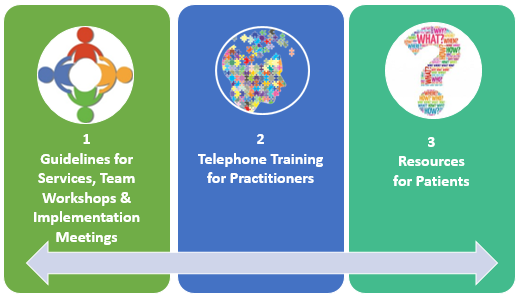
Developing the EQUITy behaviour change intervention
During the first phase of the EQUITy programme we conducted several studies and gained a comprehensive understanding of the barriers and enablers associated with the delivery of telephone treatment at Step 2 care in Improving Access to Psychological Therapies (IAPT) services. So… What do we do with the wealth of evidence we collected?
As part of the second phase of the EQUITy programme we aimed to develop an intervention to enhance the quality and ease of delivering telephone-based psychological interventions. So… How do we translate our understanding into a successful intervention to be use in routine clinical practice?
Our intervention development journey included three stages:
- Synthesising the evidence we gathered from the first phase of the EQUITY programme
- Meeting with people that will use the intervention in practice (i.e. patients, practitioners and service managers/clinical leads/academics involved in training practitioners)
- Making decisions to finalise the intervention and making sure is practical
First stage: Synthesising evidence
In a programme team meeting, we synthesised the evidence gathered from the first phase of the EQUITY programme and to do this we followed an approach called behaviour change wheel (Michie, Atkins, & West, 2014). In brief, this approach focuses on the identification of key behaviours that need to change and from whom to successfully achieve a specific aim. The aim of our intervention was to improve quality of care of psychological treatments delivered by telephone and increase engagement from patients towards this mode of delivery. During the meeting, we identified the key behaviours that were needed to promote changes from mental health services, practitioners and patients and those were then included in a questionnaire.
Second stage: Meeting with people that will use the intervention in practice
Using the questionnaire developed on the first stage, we met and discussed the proposed intervention with people that was going to use the telephone intervention in practice, i.e. patients, practitioners and key informants (e.g. service managers, clinical leads, academics involved in training practitioners). We met with each of these three groups independently and we identified ‘essential’ elements for inclusion in the intervention for each of these groups.
Third stage. Making decisions to finalise the intervention and making sure is practical
In a programme team meeting, we discussed views from the three groups (patients, practitioners and key informants) and elements considered ‘key’ by a majority of groups were then included in the final intervention. We then considered how to make the intervention accessible, practical and easy to implement in practice.
The EQUITy intervention that was developed as part of the second phase of the research programme was then tested in a feasibility study involving three IAPT services. We received feedback from patients and professionals (i.e. practitioners and service leads) and make changes following their advice. So… What does the EQUITy intervention package include?
The EQUITy intervention package is comprised of three elements:

Each of the three elements are equally important; they interact with each other, and the implementation of the three is most likely to enhance the quality of psychological interventions delivered by telephone.

0 Comments